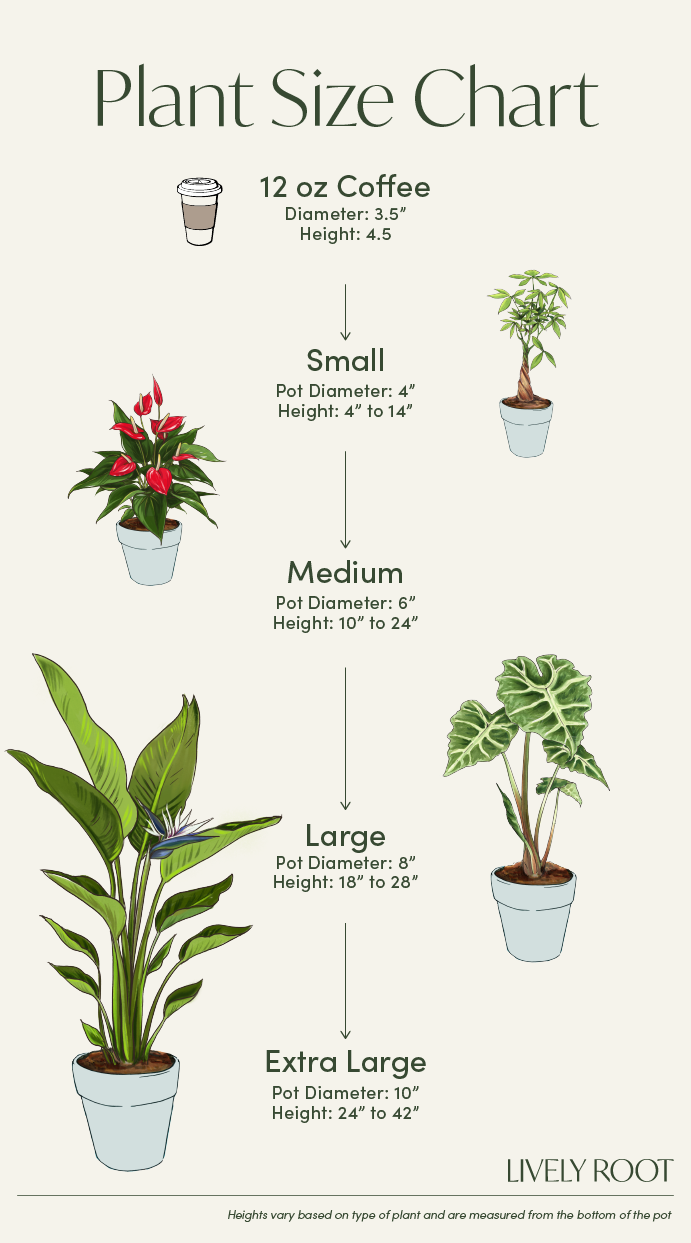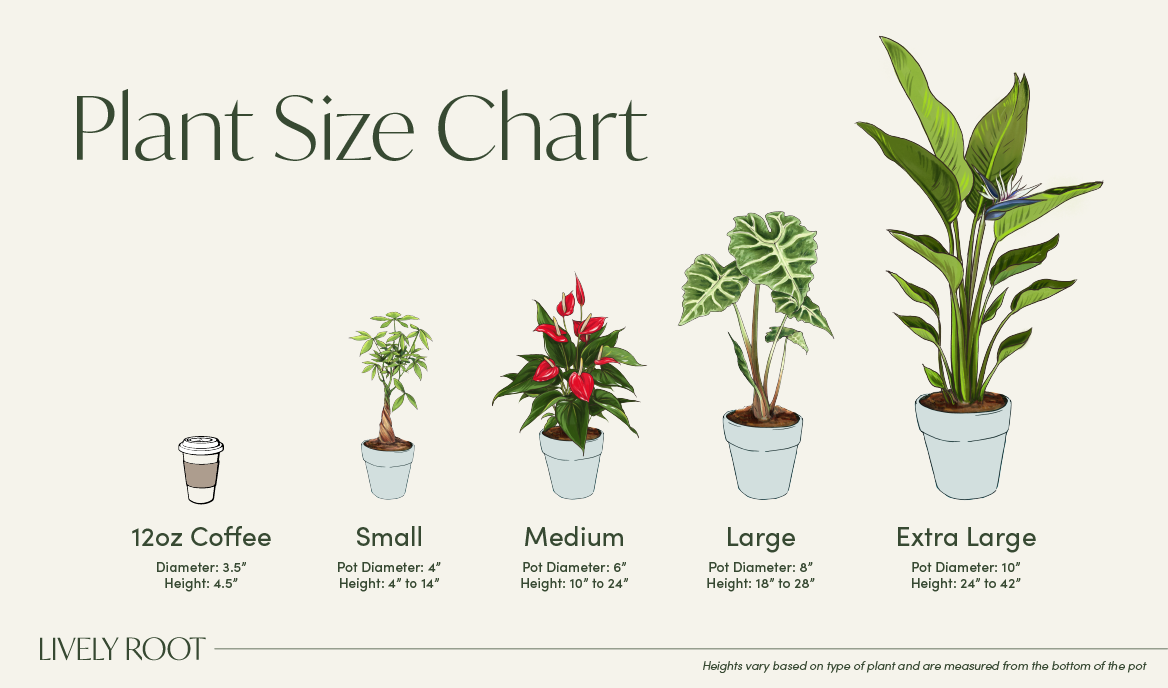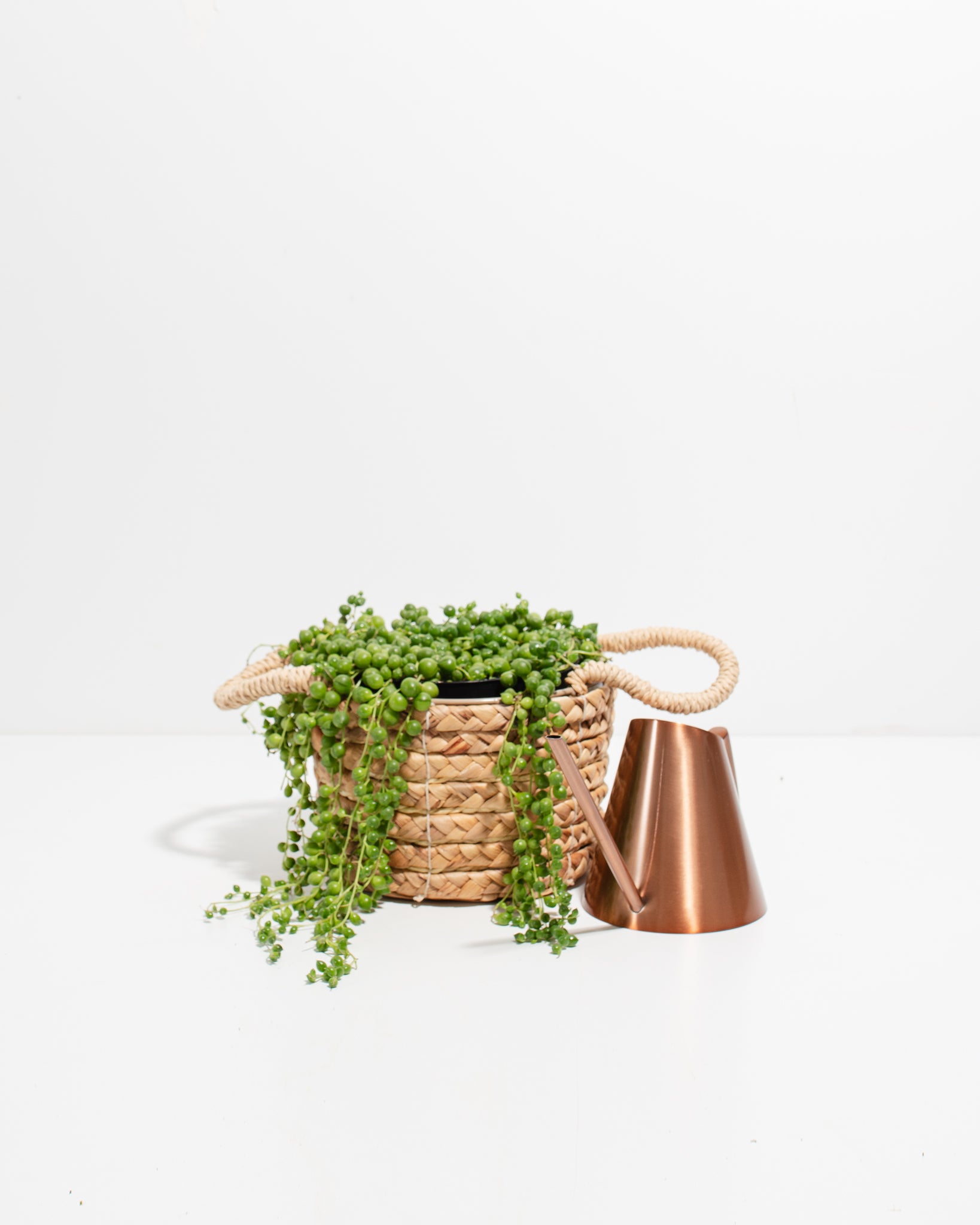

Who doesn't love a succulent with this unusual beauty flowing from all directions, right? The String of Pearls plant thrives in bright indirect light and low humidity. Add this one-of-a-kind succulent to your 'must-have' list!
String of Pearls Care Guide & Presentation

Filtered light or bright shade outdoors is best. Ideally bright morning sun is best; Bright indirect light indoors. The lower the light, the more straggly it will become.
Weekly watering is sufficient. Use filtered, bottled, or tap water sitting 24 hours to release the chemicals and water enough that the water discharges out of the drainage holes. Once the water is fully drained, replace it into the cache or decorative pot. This plant likes to be kept slightly moist during the growing season but cut back watering in the winter months. The stems are thin and can dry out quickly so don't let the soil get bone dry or the little pearls will shrivel up. Once established, this plant is drought tolerant outside.
It can tolerate low humidity.
Indoor temperature between 65-75°F. No drafts or fluctuations in temperature. You can force this plant into dormancy and keep in a room at 55-60°F to bloom better the following spring while overwintering.
Outdoors in filtered light or bright shade where nights are above 50°F. If growing in a pot, overwinter in colder regions below 50°F. Indoors, give them bright, indirect light.
Use cactus and succulent food concentrate and dilute as directed on the container.
Fast draining succulent or cactus potting mix is an excellent choice to use for this succulent. Choose a high enough pot or hanging basket so the plant's tendrils can hang over the pot or basket. Only enlarge the container by one pot size.
To prepare for the transfer and secure the tender tendrils, gently drape them onto the top of the soil. To avoid backfilling as much, work the soil up the container pot's side before placing the plant inside. If possible, to avoid breaking any tendrils, cut the grower pot down one side and gently pull the container apart to lift out the root system. Sit the root system into the new pot and add extra soil around the sides, leaving no air bubbles and pack down tightly. Gently unfold the string of pearls stems down the sides of the pot all the way around to hang properly. Water well and allow a month before fertilizing.
Trim stems on the side to promote growth. Begin trimming early in growth to get a fuller foliage on top. Us the stem cuttings in propagation.
In the spring and summer, clip off a string and separate into a single strand. Use succulent and cactus soil mix and dampen. Lay the whole stem in a circle on top of the soil and the stem will root and grow tendrils. Or, remove some of the pearls at the base of the stem, dip in rooting hormone and push down into the soil. Let them hang over and drape around the pot. Use several cuttings to start in your new planter.
Strings of Pearls Plant: Overview
The Strings of Pearls plant, scientifically known as Senecio rowleyanus, belongs to the Asteraceae family. Originating from South Africa, this unique succulent is prized for its distinctive appearance, resembling a string of beads or pearls cascading down from its hanging stems.
Each pearl has a clear strip that acts as a light into the leaf to harness more energy for photosynthesis.
Ideal for hardy zones 9 - 11, the String of Pearls thrives in warm climates but can be grown indoors in colder regions. As a groundcover or hanging plant, it adds a touch of elegance to any space.
Interestingly, its pearl-like leaves serve as water storage organs, making the plant highly drought-tolerant. However, it requires bright, indirect light and well-draining soil to thrive.
While its trailing vines make it an excellent decorative addition, the String of Pearls plant is toxic to pets if ingested.
Explore our succulent collection to find more Senecio succulent varieties, such as String of Tears and String of Dolphins, available on Lively Root.
String of Pearls: Benefits
- Strong air-purifying properties, improving indoor air quality
- Adds a touch of elegance and charm to indoor and outdoor spaces
- Known for its traditional medicinal properties and association with good luck
- Requires minimal maintenance, making it an ideal choice for busy plant enthusiasts
Strings of Pearls Plant: Common Names
- String of Beads
- Rosary Plant
- Bead Plant
- Necklace Plant
Strings of Pearls Plant Care Guide
Strings of Pearls is a low-maintenance succulent, making it ideal for beginner and experienced plant enthusiasts.
Light Requirements and Watering
Place your succulent plant in bright, indirect sunlight and water thoroughly when the soil is dry. Allow the soil to dry out between waterings to prevent root rot.
Temperature and Humidity
These indoor plants thrive in average room temperatures and don’t require high humidity levels. However, your String of Pearls may benefit from occasional misting during dry weather.
Soil and Repotting
Use a well-draining succulent or cactus potting mix to ensure proper drainage. Repot your Strings of Pearls every 2-3 years to refresh the soil and provide more space for growth.
Feeding and Propagation
Fertilize your plant sparingly during the growing season with a balanced succulent fertilizer diluted to half strength. Propagate by taking stem cuttings and allowing them to callus before planting in well-draining soil.
Pruning and Cleaning
Trim leggy or damaged stems to encourage bushier growth. Remove debris or dead leaves from the plant to prevent pests and diseases.
Common Issues
Watch out for signs of overwatering, such as yellowing or mushy stems, and adjust your watering schedule. Additionally, adequate airflow around the String of Pearls plant should be ensured to prevent fungal diseases.
Strings of Pearls: Placement, Companion & Alternative Plants
Finding the perfect spot for your Strings of Pearls is essential for its health and growth. To complete this unique succulent, let’s explore placement options and companion plants. If you have pets, consider growing some alternative green beauties.
Best Locations & Uses
- Ideal for hanging baskets, allowing its trailing vines to cascade gracefully
- Perfect for bright, indirect light conditions, such as near a sunny window or under a skylight
- Adds a whimsical touch to shelves or mantels, draping elegantly over the edges
- Thrives in outdoor containers on patios or balconies with filtered sunlight
- A relatively small plant, which makes a stunning centerpiece when displayed in a decorative pot on a tabletop or desk
Companion Plants
Enhance the beauty of your Strings of Pearls with these complementary companions:
- Spider Plant (Chlorophytum comosum): Known for its air-purifying qualities, the Spider Plant, with its lush foliage, contrasts beautifully with the delicate strands of the Strings of Pearls.
- Golden Pothos (Epipremnum aureus): With its trailing vines and heart-shaped leaves, the Golden Pothos adds a lush green backdrop that highlights the unique appearance of the Strings of Pearls.
- Begonia (Begonia boliviensis): The vibrant colors and interesting leaf shapes of Begonias create a striking visual contrast when paired with the delicate pearls of the Strings of Pearls.
Alternative Plants
Explore these pet-friendly alternatives to the Strings of Pearls:
- Boston Fern (Nephrolepsis exaltata): Known for its graceful fronds and air-purifying qualities, the Boston Fern thrives in similar conditions to the Strings of Pearls, making it a perfect alternative for pet owners.
- Chinese Money Plant (Pilea peperomioides): The Chinese Money Plant is perfect for pet owners looking for a safe and stylish green addition to their home.
- Neanthe Bella Palm (Chamaedorea elegans): With its compact size and graceful fronts, the Neanthe Bella Palm is safe for pets and adds a tropical vibe to any room.
Get Strings of Pearls Plant for Sale From Lively Root
Bring a touch of natural elegance into your home or office with our Strings of Pearls plant. Shop now and elevate your space with this unique and eye-catching addition!






















